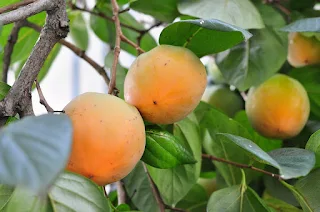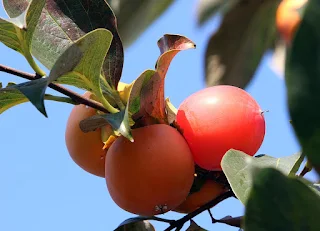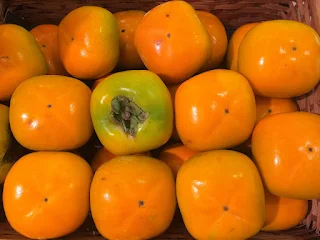The Delightful Persimmon: A Nutritional Powerhouse You Can Eat in Many Ways
The persimmon, a vibrant orange fruit with a unique shape and taste, is a hidden gem in the world of produce. Not only is it visually striking, but it also boasts a surprising amount of beneficial nutrients.
Let's delve into the world of persimmons, exploring their nutritional profile and how you can incorporate them into your diet in delicious ways.
A Treasure Trove of Nutrients
Persimmons come in two main varieties: astringent (hachiya) and non-astringent (hachiya). Astringent persimmons have a higher tannin content, giving them a puckering sensation when unripe.
As they ripen, the tannins decrease, making them sweeter and less astringent. Non-astringent persimmons are softer and sweeter even when unripe.
Regardless of the variety, persimmons are a nutritional powerhouse. Here's a closer look at what a single serving (around 168 grams or 6 ounces) of a Japanese persimmon offers:
- Calories: Low in calories, with only around 118 per serving.
- Carbohydrates: A good source of carbs (around 31 grams), primarily in the form of natural sugars.
- Fiber: Packed with dietary fiber (around 6 grams), promoting gut health and aiding digestion.
- Vitamins: Rich in vitamins A and C, essential for maintaining healthy vision and immune function. A serving provides about 15% of the Daily Value (DV) for vitamin A and 14% of the DV for vitamin C.
- Minerals: Contains a good amount of minerals like potassium (important for regulating blood pressure), manganese (supporting enzyme function), and copper (contributing to collagen production).
In addition to these, persimmons are a source of vitamin B6, folate, magnesium, phosphorus, and various plant compounds like tannins, flavonoids, and carotenoids. These compounds offer antioxidant benefits, potentially reducing the risk of chronic diseases.
How to Enjoy Persimmons
The beauty of persimmons lies in their versatility. You can enjoy them ripe or unripe, depending on the variety and your taste preference. Here are some ways to incorporate persimmons into your diet:
- Fresh Snack: When perfectly ripe, simply wash, peel (optional for non-astringent varieties), and enjoy the fruit's natural sweetness.
- Salad Addition: Chopped persimmons add a burst of sweetness and vibrant color to salads. Pair them with leafy greens, feta cheese, and a light vinaigrette for a refreshing salad.
- Yogurt Parfait: Layer diced persimmons with yogurt, granola, and a drizzle of honey for a nutritious and satisfying breakfast or snack.
- Baked Delights: Use persimmon puree as a substitute for applesauce in muffins, cakes, and breads. The natural sweetness adds a delightful twist to baked goods.
- Savory Surprise: Believe it or not, persimmons can also be enjoyed in savory dishes! Try adding sliced persimmons to stir-fries, curries, or rice bowls for a unique sweet-and-savory flavor profile.
- Dried Treat: Dried persimmons are a chewy and concentrated source of nutrients. Enjoy them on their own or chopped up in trail mix for a healthy energy boost.
Tips for Selecting and Storing Persimmons
When choosing persimmons, look for fruits that feel slightly soft to the touch, with no blemishes or bruises. Unripe astringent persimmons can be stored at room temperature until they soften.
Once ripe, store them in the refrigerator for a few days. Non-astringent persimmons can be stored at room temperature or in the refrigerator depending on their ripeness.
Here's a helpful tip: To accelerate the ripening of astringent persimmons, place them in a paper bag with an apple or banana. The ethylene gas released by these fruits will speed up the ripening process.
Persimmon Powerhouse: A Global Look at Production and Trade
The persimmon, a symbol of longevity and prosperity in some cultures, is not just a beautiful fruit but also a significant player in the global produce market.
With its origins tracing back to Eastern Asia, persimmon cultivation has spread worldwide, leading to a fascinating story of production and trade.
Let's delve into the world of persimmon production, exploring the leading producers, major trade routes, and emerging trends.
Kings of Persimmon Cultivation: A Production Powerhouse
China takes the undisputed crown as the world's leading producer of persimmons. As of 2022, estimates suggest China produced a staggering 3.4 billion kilograms (7.5 billion pounds) of persimmons, accounting for a dominant share of global production.
This dominance can be attributed to several factors, including a long history of persimmon cultivation, favorable growing conditions in various regions, and a strong domestic demand for the fruit.
Following China are other major producers like South Korea (231.5 million kg), Japan (216.1 million kg), Azerbaijan (184.3 million kg), and Brazil (164.4 million kg).
It's interesting to note the geographic diversity of these top producers. While China, South Korea, and Japan represent the Asian stronghold of persimmon production, Azerbaijan in the Caucasus region and Brazil in South America showcase the fruit's increasing global footprint.
Production trends reveal a fascinating story. While China has maintained a steady growth trajectory in recent years, some established producers like South Korea have seen a slight decline.
This could be due to factors like shifting consumer preferences, competition from other fruits, or challenges related to cultivation practices.
On the other hand, some countries are emerging as exciting new players in the persimmon production scene.
Countries like Spain, with its focus on export-oriented varieties, have witnessed significant growth in production. Notably, Spain has become a major exporter of persimmons, particularly to European markets.
Global Trade Routes: Sharing the Persimmon Bounty
Persimmons are not just enjoyed domestically; they also participate in a dynamic global trade network.
Leading the export front is Azerbaijan, a country strategically located at the crossroads of Europe and Asia. In 2023, Azerbaijan's persimmon exports reached an estimated value of USD 189.57 million, showcasing its crucial role in supplying persimmons to international markets.
Following Azerbaijan are established exporters like Spain and Israel. Spain, leveraging its expertise in cultivating export-friendly varieties, ships persimmons primarily to European countries like Germany (the world's largest persimmon importer by value) and France.
Israel, known for its high-quality "Sharon fruit" variety, caters to markets in Europe and North America.
New Zealand is another noteworthy player in the persimmon export scene. With a focus on the non-astringent "Fuyu" variety, New Zealand has successfully established itself as a reliable supplier to Asian markets, particularly Japan and China.
This highlights the growing intra-regional trade within Asia, driven by a shared appreciation for the fruit.
Emerging Trends: The Future of Persimmon Production and Trade
The future of persimmon production and trade promises to be exciting. Here are some key trends to watch:
- Focus on New Varieties: Breeders are constantly developing new persimmon varieties with improved characteristics like extended shelf life, resistance to diseases, and even sweeter flavors. This could lead to wider consumer acceptance and increased trade opportunities.
- Sustainability in Production: As environmental concerns rise, producers are likely to adopt more sustainable practices like integrated pest management and water conservation techniques. This will ensure a long-term future for persimmon cultivation and cater to the growing demand for ethically sourced produce.
- Expansion into New Markets: As the health benefits of persimmons gain recognition, exploration of new markets, particularly in North America and emerging economies, is expected. This will require tailored marketing strategies to educate consumers about the fruit's unique qualities.
In conclusion, the persimmon industry is a vibrant and dynamic sector on the global stage. From China's dominant production to the strategic trade routes established by Azerbaijan and Spain, the story of persimmons is one of international collaboration and delicious exploration.
As new varieties emerge, sustainable practices are adopted, and new markets are explored, the future of persimmons promises to be even brighter, offering a taste sensation enjoyed worldwide.
Image Credits: Pixabay
Disclaimer: This blog post is for informational purposes only and is not intended to be a substitute for professional medical advice. Always consult with your doctor before making any changes to your diet or lifestyle.
NOTE : "Information provided by Gemini, a large language model from Google AI."


.jpg)





.jpg)